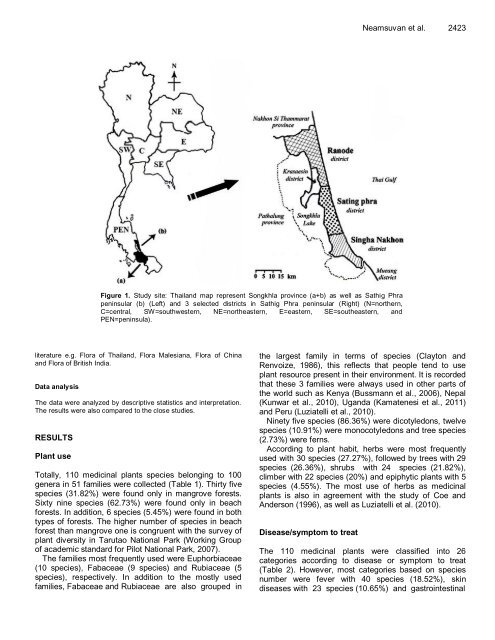Download Complete Issue - Academic Journals
Download Complete Issue - Academic Journals
Download Complete Issue - Academic Journals
You also want an ePaper? Increase the reach of your titles
YUMPU automatically turns print PDFs into web optimized ePapers that Google loves.
Figure 1. Study site: Thailand map represent Songkhla province (a+b) as well as Sathig Phra<br />
peninsular (b) (Left) and 3 selected districts in Sathig Phra peninsular (Right) (N=northern,<br />
C=central, SW=southwestern, NE=northeastern, E=eastern, SE=southeastern, and<br />
PEN=peninsula).<br />
literature e.g. Flora of Thailand, Flora Malesiana, Flora of China<br />
and Flora of British India.<br />
Data analysis<br />
The data were analyzed by descriptive statistics and interpretation.<br />
The results were also compared to the close studies.<br />
RESULTS<br />
Plant use<br />
Totally, 110 medicinal plants species belonging to 100<br />
genera in 51 families were collected (Table 1). Thirty five<br />
species (31.82%) were found only in mangrove forests.<br />
Sixty nine species (62.73%) were found only in beach<br />
forests. In addition, 6 species (5.45%) were found in both<br />
types of forests. The higher number of species in beach<br />
forest than mangrove one is congruent with the survey of<br />
plant diversity in Tarutao National Park (Working Group<br />
of academic standard for Pilot National Park, 2007).<br />
The families most frequently used were Euphorbiaceae<br />
(10 species), Fabaceae (9 species) and Rubiaceae (5<br />
species), respectively. In addition to the mostly used<br />
families, Fabaceae and Rubiaceae are also grouped in<br />
Neamsuvan et al. 2423<br />
the largest family in terms of species (Clayton and<br />
Renvoize, 1986), this reflects that people tend to use<br />
plant resource present in their environment. It is recorded<br />
that these 3 families were always used in other parts of<br />
the world such as Kenya (Bussmann et al., 2006), Nepal<br />
(Kunwar et al., 2010), Uganda (Kamatenesi et al., 2011)<br />
and Peru (Luziatelli et al., 2010).<br />
Ninety five species (86.36%) were dicotyledons, twelve<br />
species (10.91%) were monocotyledons and tree species<br />
(2.73%) were ferns.<br />
According to plant habit, herbs were most frequently<br />
used with 30 species (27.27%), followed by trees with 29<br />
species (26.36%), shrubs with 24 species (21.82%),<br />
climber with 22 species (20%) and epiphytic plants with 5<br />
species (4.55%). The most use of herbs as medicinal<br />
plants is also in agreement with the study of Coe and<br />
Anderson (1996), as well as Luziatelli et al. (2010).<br />
Disease/symptom to treat<br />
The 110 medicinal plants were classified into 26<br />
categories according to disease or symptom to treat<br />
(Table 2). However, most categories based on species<br />
number were fever with 40 species (18.52%), skin<br />
diseases with 23 species (10.65%) and gastrointestinal

















